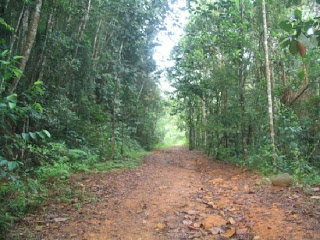Wednesday, September 11, 2013
Sinharaja Forest
Sinharaja Forest Reserve is placed within the south-west lowland wet zone of state. Most of the area was originally declared a forest reserve on 1875 below the Waste Lands Ordinance and notified within the Ceylon Government, whereas the rest was notified a proposed forest reserve within the early twentieth century. Sinharaja Forest Reserve, comprising the existing and proposed forest reserves, was declared a region reserve in 1978.
This narrow strip of undulating parcel of land consists of a series of ridges and valleys. two main forms of forest will be recognized: remnants of Dipterocarpus forest occur in valleys and on their lower slopes; secondary forest and scrub occur where the first forest cowl has been removed by shifting cultivation and in different places the forest has been replaced by rubber and tea plantations. Mesua-Doona forest is the climax vegetation in most of the reserve. Of Sri Lanka's 830 endemic species, 217 trees and woody climbers ar found within the lowland wet zone. different rare endemics ar the palm, the latter being restricted to Sinhagala. a range of plants of legendary benefit to man ar gift, of which palm (for saccharide, a sugar substitute), wewal, cardamom, dun (for varnish and incense) and weniwal (for healthful purposes) ar used intensively by villagers.
Endemism is high, notably for birds, mammals and butterflies. vulnerable mammals ar leopard and indian elephant. Birds thought-about to be endangered or rare are state wood pigeon, green-billed cuckoo, Sri Lanka white-headed oscine, state blue magpie, ashy-headed babbler and red-faced malkoha. Of interest is the presence of the state broad-billed roller. Reptiles and class Amphibia include the python, which is vulnerable, and variety of endemic species. Noteworthy species include the rarest of all agamids on the island, the rough-nose horned toad and a rare endemic microhylid. vulnerable seafood ar combtail, smooth-breasted Chelone glabra, black ruby barb, cherry barb and red-tail percoidean. Sri Lankan five-bar blade, which is taken into account to be very rare, is not uncommon in Sinharaja at sure times of the year.
The Sinharaja region has long featured within the legends and lore of the folks of state. Its name, literally which means lion (sinha ) king (raja ), maybe refers to the first 'king-sized or royal forest of the Sinhalese', people of the legendary 'lion-race' of state, or to the house of a legendary lion of state.
There ar two villages at intervals the south-west of the reserve, and concerning 52 families board the north-western sector. at least twenty different settlements occur on the periphery, associate degree unknown number of which have been illegally established on state land while not approval from the relevant authorities.
Sinharaja Forest Reserve is the last viable remnant of Sri Lanka's tropical lowland rainforest; over hour of the trees ar endemic and lots of of those ar rare; and there ar 21 endemic bird species still as variety of rare insects, reptiles and amphibians.
Subscribe to:
Post Comments (Atom)

No comments:
Post a Comment